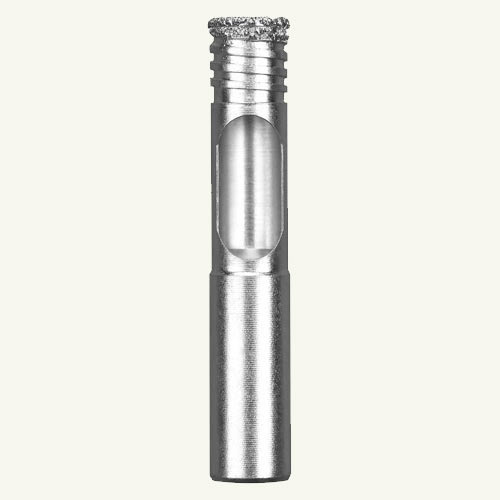Almost every home diy handyman will eventually face the daunting task of drilling holes in ceramic tile. The most common occurrences being, hanging towel bars and shower rods in bathrooms. Drilling holes in ceramic tile is not difficult, it requires some patience and as with most projects, the proper tools for the job.
Note: This information is for drilling a hole in ceramic tile, not in porcelain, glass, marble, granite or natural stone. To drill holes in any of those materials follow this link - Other Materials

Figure 1 - Shower rod mounted on ceramic tile
Ceramic tile is very hard and is much more difficult to drill through than either wood or metal. Because of its hardness it is necessary to use a special drill bit that is manufactured with a carbide tip.
Although not required, you can also use a diamond tipped drill bit.

Carbide Tipped Drill Bit

Diamond Tipped Drill Bit
Carbide is a very strong material that has the ability to drill through ceramic tile. The drill bit is manufactured slightly differently than a wood or metal bit. The tip of the bit, which is the diameter of the drill bit is the size of the desired hole, but the balance of the shank of the bit is slightly smaller than the tip.

Figure 2 - ceramic tile with duct tape marked for drilling
To drill a hole in ceramic tile:
- Use duct or masking tape over the surface area of the ceramic tile where the hole is to be drilled. This helps to prevent the drill bit from
walking
when starting to drill the hole. Duct and masking tape is easier to write on than the ceramic tile itself. - Measure and mark the location of the holes. Then measure again - you cannot measure to many times!
- The drill must be at right angle to the hole to be drilled.Do not attempt to drill on an angle. Carbide drill bits are meant to drill using the tip and sides of the tip evenly. Drilling on an angle will most likely cause the drill bit to burn and the tile to crack.
- Use a variable speed drill set on a speed of 100 to 200 rpm. NEVER USE A HAMMER DRILL ON CERAMIC TILE!.
- Apply a light pressure to the drill. Applying to much pressure will burn the drill bit.
- Use a spray bottle filled with water to keep the drill bit cool. It is best if you have a second person spraying the drill bit, so that you can concentrate on keeping the drill bit at right angles to the ceramic tile.
Carbide bits do not have long lives. Always inspect you drill bit prior to use. If the tip is discolored, chipped and/or dull, discard it and use a new bit. Using a bit that is discolored, chipped and/or dull may result in having a tile crack as you attempt to drill through it.
It is not always possible to pick the location of a hole or group of holes as the location may be defined by the item you are attaching. However, if you can choose the location, always drill as close to the center of any specific ceramic tile. The closer you are drilling to an edge, the more chance that the tile will crack.

Figure 3 - Drilling hole in grout between two tiles
One of the most difficult holes to drill, without cracking or chipping ceramic tiles, is a hole in the grout joint that is wider than the grout joint itself. This is caused by the difference in the density of the grout versus the ceramic tile. As the drill bit enters the grout, the tip of the drill bit is clear of the edge of the tile, but as it penetrates the grout, the side of the drill bit hits the edge of the tile on an angle, causing a chip or cracking.
There is no easy way around this problem. If you are faced with this situation, when drilling, do not apply much pressure against the drill bit. Allow the drill bit to do the work.
Carbide drill bits do not work well in wood or steel, although they do work well in plaster, concrete board or drywall.
If when you drill the hole, penetrating the ceramic tile and the material behind the ceramic tile that you have hit is either a metal or a wood wall stud, rather than open wall space - stop drilling immediately and switch to an appropriate drill bit for that material. It is generally wise to use a drill bit one size smaller to avoid having that drill bit attempt to enlarge the hole drilled in the ceramic tile by the carbide drill bit. A carbide drill bit will burn out in seconds if you try to use it to drill in wood or metal.
Never attempt to use a screw that has a larger outside diameter than the inside diameter of the hole that you have drilled. You cannot thread into ceramic tile. Use an appropriate size and function wall anchor in the hole that you have drilled. The ceramic tile should not be carrying any weight directly.
If you are drilling holes greater than 5/8 inch you should consider using a diamond tipped hole saw, as shown in Figure 4. Carbide drill cutters are made to make larger holes in ceramic tile for shower faucets and other accessories. However, if you are planning on using a one of these tools, make sure you have additional tiles available as they have a tendency to crack the tiles especially if you are cutting on the grout lines of the tiles.

Figure 4 - Diamond Tipped Hole Saws
Additional information:
Drill Speeds - Hardwood and Softwood
Drill Speeds - Brass, Aluminum, Steel
Drill Speeds - Acrylic and Polycarbonate
How To Drill - Porcelain, Marble & Granite
